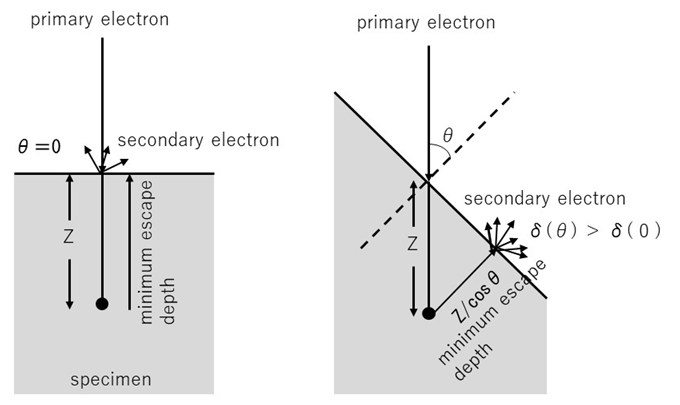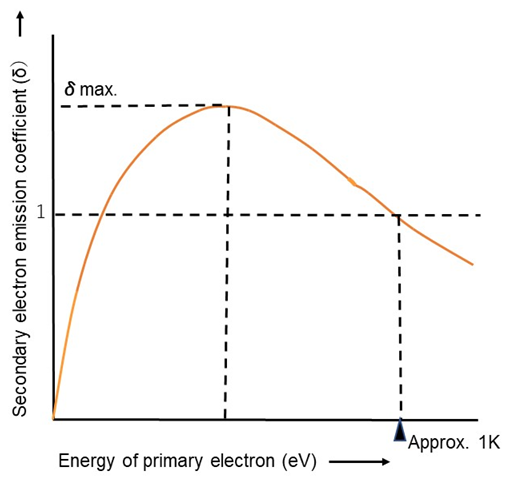二次電子放出率
二次電子放出率
secondary yield, secondary electron emission coefficient
[目次:理論]
試料に入射する電子(一次電子)の数と、試料から放出される二次電子の数の比δ。実際には、二次電子放出率δは試料に入射する一次電子電流Ipと試料から放出される二次電子電流Isの比Is/Ipとして定義される。二次電子放出比とも呼ばれる。
二次電子放出率δの試料傾斜角依存性
二次電子はエネルギーが最大でも数10 eVと小さいため、試料表面から10 nm程度の浅いところからしか放出されない。このことは、試料の入射電子線に対する傾斜角度が大きくなれば、δが増えることを意味する。下図(a)にその概念を示す。ここで、一次電子と一次電子の入射点における法線とのなす角度をθとする。一次電子が試料表面に垂直に入射した場合(θ=0)、最短脱出距離Zで二次電子が一番多く放出される。試料がθ傾斜すると、最短脱出距離は、Z・cosθとなり、θ=0に比べて二次電子が放出し易くなり、δが大きな値となる。したがって、二次電子像では試料表面の形状(傾き)によるコントラストが得られる。
二次電子放出率δの加速電圧依存性
δの加速電圧(一次電子のエネルギー)依存性を下図(b)に示す。δは、一次電子のエネルギーが数100 eV程度までは増加し、300~800 eV(物質によって異なる)で最大値δmaxを取る。その後一次電子のエネルギーが大きくなるにしたがい、δは低下する。
図(a) 二次電子放出率の傾斜依存性⇒図
図(b) 二次電子放出率の加速電圧依存性⇒図
The ratio (δ) of the number of secondary electrons emitted from a specimen to the number of incident electrons (primary electrons) onto the specimen. The emission ratio (coefficient) δ is defined as Is/Ip, where Is is the electric current of the secondary electrons and Ip is the electric current of the primary electrons.
- Dependence of δ on the angles of the specimen surface against the incident electron probe
Since the secondary electron energy is very small to be a few 10 eV even at maximum, the electrons excited only near the surface (approximately 10 nm thick from the surface) are emitted beyond the surface. This indicates that δ increases when the tilt angle of the specimen is large against the specimen surface as is shown in Fig. (a). In Fig. (a), let θ be the angle between the primary electron beam and the normal to the specimen surface at the incident point of the primary electrons: θ=0 for the perpendicular incidence of the primary electrons onto the specimen surface. For the perpendicular incidence, the number of secondary electrons emitted from the specimen becomes the largest at the minimum escape depth Z. When the specimen is tilted by θ, the minimum escape depth becomes small to Z・cosθ. Then, the secondary electron emission increases with increasing θ, compared to the case of θ=0. This means that the secondary electron image provides contrast dependent on tilt of the specimen against the incident beam. - Dependence of δ on accelerating voltages
Fig. (b) shows the dependence of δ on the accelerating voltage of the primary electrons. δ increases with the accelerating voltage until about several 100 eV. That is, δ takes maximum at voltages between 300 to 800 eV (different for constituent materials) and then decreases gradually with increasing the accelerating voltage.

Fig. (a) Dependence of secondary electron emission on specimen tilts

Fig. (b) Dependence of secondary electron emission coefficient on accelerating voltages (δmax is less than 1 for some materials)
関連用語から探す
説明に「二次電子放出率」が含まれている用語






